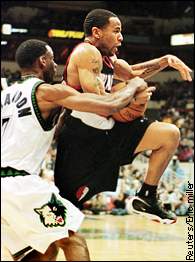 |
|
| | Wednesday, December 8 | |||||||||||||||||||||||||||||||||||||
Special to ESPN.com | ||||||||||||||||||||||||||||||||||||||
What's caused this disparity in success among the three teams? The Blazers simply were more effectively managed than the others. During the early years of its existence, Portland made consistently good choices in its player selections while under the leadership of Stu Inman, Director of Player Personnel. Key players secured through the college draft included Bill Walton, Bob Gross, Lionel Hollins, Lloyd Neal, Johnny Davis, Dave Twardzik, Clyde Drexler, Mychal Thompson, Terry Porter, Jim Paxson and Jerome Kersey. Maurice Lucas was acquired from the ABA disposal draft. Many of those players were prominent on the championship team -- that yet remains dear to the hearts of Blazer fans -- while the others were on teams that consistently posted winning records. During the more recent tenure of "Trader Bob" Whitsitt, now in his sixth year as president-GM, the Blazers have done less with draft choices and more by trades and free agent signings. Only two members of the present team, Arvydas Sabonis (first round pick, 24th overall, in 1986) and Jermaine O'Neal were acquired via the NBA draft. The rest of the squad is the result of deals and signings of available players, engineered by Whitsitt and aided in no small measure by the "open purse" policy of owner Paul Allen. Trader Bob has made 14 trades and acquired 14 lottery players without having a lottery pick. After the Blazers were swept by San Antonio in the conference finals last season, Whitsitt decided to go all out to win a title this year. His principal additions -- Scottie Pippen, Steve Smith and Detlef Schrempf - make the Blazers one of the NBA's top teams.
Trades, Free Agents and Draft Picks
Strengths and weaknesses When I watch the Blazers, I'm impressed with the execution of offense; the tough, unyielding defense; the willing acceptance of Dunleavy's game plan; and the obvious team harmony, devoid of the distractions that accompanied Rider. Coach Mike uses his roster well -- nobody plays excessive minutes, and everyone makes a positive contribution. His pressing team (Anthony, Augmon, Harvey, Wells -- now injured), and either Schrempf, Grant or Pippen jump-starts the team into an uptempo game if the starters are sluggish. Players enter the game enthusiastically and leave the floor without rancor. It's nice to watch. Portland usually ranks one-two with San Antonio in each week's team ratings on vital statistics relating to offense and defense. The Blazers allow opponents to shoot .397 from the field, and shoot .470 themselves -- both excellent marks. Their point differential (the difference between points they score and allow) is at the top of the league -- also with the Spurs. They also rank among a few of the best teams in total assists and defensive rebounding. Portland's weakness is apparent only against teams with strong, quick centers. Sabonis is a highly skilled center with a clever inside-outside game and great passing skills. But he has difficulty defending quicker matchups -- such as Shaquille O'Neal and David Robinson. Unfortunately, both of them play on teams that stand between the Blazers and the Western Conference championship. In the Blazers' recent loss to the Lakers, Sabonis scored two points, had two rebounds and five personal fouls in 17 minutes of play. To counter this problem, Dunleavy might experiment with a three-forward front line in regular season games with the Spurs and Lakers to get a sense of its effectiveness. He might find that he can create matchup problems for both Shaq and David that would help overcome their apparent advantage. If the Blazers can't stop either player from scoring, they could make them work harder on defense by taking them away from the basket area to defend perimeter-shooting, driving big men like Wallace or Grant. Coach Mike has a shrewd basketball mind, and has plenty of time, plus enough head-to-head games with the Spurs and Lakers, to work that one out.
Until then, the Blazers will continue to dominate the lesser teams. They are
15-4 overall (including 9-3 on the road) -- not all that bad. | ALSO SEE Dr. Jack's Team Spotlight: Pacers Dr. Jack's Team Spotlight: Hawks Pippen, Blazers toying with opposition  | |||||||||||||||||||||||||||||||||||||

